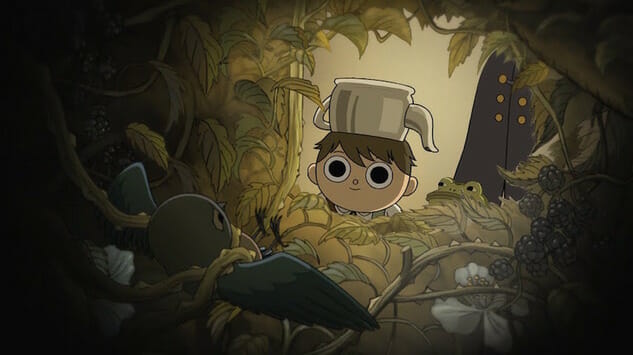TV Rewind: Over the Garden Wall Endures as a Captivating Halloween Folktale
Photo Courtesy of Cartoon Network
Editor’s Note: Welcome to our TV Rewind column! The Paste writers are diving into the streaming catalogue to discuss some of our favorite classic series as well as great shows we’re watching for the first time. Come relive your TV past with us, or discover what should be your next binge watch below:
![]()
Growing up in central Texas, I only ever knew two seasons: summer and not-summer. Summer stews from March to October. Not-summer encompasses everything else. If I’m lucky, I experience a couple forlorn weeks of fall in November, but the concept of four delineated seasons feels fantastical in a delightfully pedestrian sort of way. Yet I can’t help myself from yearning for an idyllic fall made up of apple orchards and When Harry Met Sally sweaters. I pine for an autumnal wind rustling the trees in a pumpkin patch. The mere thought of leaves crunching under boots makes me feral.
Enter Over the Garden Wall, Cartoon Network’s seasonal cult classic (now on HBO Max and Hulu) best served with a warm mug of apple cider.
Good folktales rely on mood-setting, and Over the Garden Wall fashions itself as a new folktale told in an old way. Created by Patrick McHale (two-time creative director for Adventure Time, now slated for Netflix’s Redwall adaptation), the 2D-animated miniseries balances the autumnal creepy/cozy dichotomy to become the perfect Halloween watch. The 10 episodes first aired over five nights in November 2014; since its release, online searches for the show have annually peaked in late October, without fail.
The premise feels as familiar as “once upon a time.” Two half-brothers, Wirt (Elijah Wood) and Greg (Collin Dean) find themselves lost in a seemingly timeless forest called the Unknown. We happen upon the pair mid-journey, unsure of when or where they come from. Fairy tales love the power of three, and Greg’s occasionally musical frog (Jack Jones), rounds out the trio. (His constantly changing name is one of the show’s running gags.) The wayfarers soon find a guide in Beatrice (Melanie Lynskey), a sardonic enchanted bluebird. In the backdrop, a malevolent presence known as the Beast (Samuel Ramey) lurks in wait, headed off by the lantern-bearing Woodsman (Christopher Lloyd).
At its heart, Over the Garden Wall is a coming-of-age story about two brothers learning how to better care for one another. Wirt exists in a perpetual state of anxiety, fretting over making decisions and taking responsibility. He’s prone to melodramatic outbursts of poetry and loves the clarinet, two pastimes that he worries brand him a weirdo. (“Those are just character traits,” Beatrice groans at one point.) Greg serves as his singing foil, endlessly optimistic and innocent, sometimes to the point of recklessness. Their interactions, complete with Beatrice’s wry observations, bring humor and warmth to the show.
Wirt and Greg’s quest for home gives the series its backbone, but the 11-minute episodes have largely self-contained plots about their interactions with the Unknown’s inhabitants. Central to the show’s success, the rich setting feels like an anachronistic New England populated by pumpkin-wearing skeletons, reclusive oddballs, and ominous specters. Dream-logic makes distance and time feel foggy. The brothers navigate from Puritan times to a 19th century schoolhouse to an old-fashioned riverboat ferrying frogs in three-piece suits and feathered hats.
-

-

-

-

-

-

-

-

-

-

-

-

-

-

-

-

-

-

-

-

-

-

-

-

-

-

-

-

-

-

-

-

-

-

-

-

-

-

-

-








































